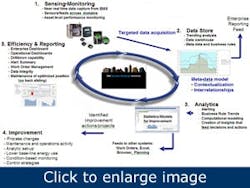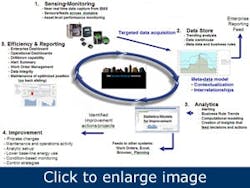How to use energy analytics to create smarter buildings
In brief:
- IBM’s Rochester, Minnesota, campus demonstrated energy cost reductions of 8% across the solution-enabled assets at a site that had already achieved annual energy reductions in excess of 6% through energy savings projects and capital investment.
- In the closed-loop intelligence system, sensing and monitoring leads to data storage, which is used for analytics that drive improvements. When reporting and sustainability and optimum operating conditions are achieved, the system repeats all over again.
- The analytics enable an understanding of the energy assets’ real-time operating variables, and that provides the ability to act immediately on operational malfunction and provide ongoing visibility to long-term energy efficiency.
With hundreds of facilities supporting its global operations, the energy conservation challenge is all too familiar to IBM. Over the years, the company took a leadership role in implementing energy conservation and building management practices that promote environmental and cost-effective operations. Huge investment has been made in global energy conservation with teams focused on driving energy efficiency programs, education programs to drive behavioral change and large capital investments to install high-efficiency equipment. These programs have been successful at driving annual savings in energy consumption, but, to achieve these reductions continually, innovation and adaptation need to be embraced and today IBM is gaining a new level of economic, operational and environmental benefit.
IBM’s Rochester, Minnesota, campus is one of the first IBM facilities to benefit. The Rochester campus consists of 3.2 million square ft of space and has more than 35 interconnected buildings, including manufacturing facilities, testing labs, office buildings and a worldwide data center. It’s the sixth-highest energy user in IBM’s global facilities portfolio, making it an ideal location to launch the program.
[pullquote]The solution for smarter buildings (Figure 1) is enabled through integrated asset and service work-order management combined with energy and sustainability management analytics. The system achieves further benefits through deeper understanding and visibility of third party facility management contracts enabled by the smarter building data analysis. The visibility this solution provides into the performance of the energy-consuming devices, along with work order management and the time from failure to correction of equipment, drives significantly improved efficiency and productivity.
The solution has helped IBM to see what its buildings are saying, in terms of energy consumption and efficiency, providing a new depth of intelligence to the building management systems of each building, resulting in an enterprise view of energy use and efficiency. The advanced operational and energy analytics uncovered previously hidden systemic operational and energy use malfunctions and inefficiency (waste), while sustaining an optimized posture. Once the problems are resolved, the solution yields a lower baseline in energy utilization, resulting in reductions in both energy and operational costs.
The results from IBM Rochester demonstrated energy cost reductions of 8% across the solution-enabled assets at an IBM site that had consistently achieved annual energy reductions in excess of 6% through energy savings projects and capital investment. The savings from this pilot were achieved through the immediate identification of equipment that had exceeded its commissioned specification and the identification of equipment operating outside of the set control strategy. In essence, the savings were delivered through in-depth knowledge of the asset, improved control strategies and systems, and improved condition-based monitoring deployed through the closed-loop management system (Figure 1).
Figure 1. Monitoring begets trending begets alerting begets improvements begets reporting begets monitoring.
The analytics provide detailed information on the efficiency and asset health, which, in turn, improve maintenance productivity and also can lead to the deferral of capital expenditure, as the accurate information provided on mature energy device performance enables the end user to make an informed decision on when replacement is necessary. The solution also delivers an increased building reliability through detailed near-real-time strategic and tactical information on critical buildings, areas and assets.
The closed-loop solution is a key enabler for further benefits through better understanding and visibility of third-party facility management contracts. Operational visibility this solution provides in relation to the performance of the energy devices, along with work order management and the time from failure to correction of equipment, drives new levels of efficiency and productivity.
The solution provides a route to improve the intelligence of buildings by transforming large amounts of existing data into intelligent and interconnected actionable information. The analytics enable insight and foresight and an understanding of the real-time operating variables of energy assets, providing the ability to act immediately on operational malfunction and provide ongoing visibility to energy efficiency over time.
Perhaps the best statement about the success of the project comes from the primary stakeholder, John DeMarco, director, real estate operations at IBM, who says, “We’ve been focused on energy management for many years. From an operational perspective, we’ve made many targeted investments in energy efficiency. We’ve installed high-efficiency instrumentation, as well as advanced sensor and metering technology, along with undertaking a long list of other conservation actions. We’ve also educated employees on how changes in the way they work could have a big effect on reducing the demand for energy. To continue to achieve year-over-year improvement in conservation, you have to develop new and innovative approaches. We need to capture data and effectively communicate new insights that change behaviors.”
The results couldn’t be stronger in terms of both financial return and customer satisfaction. The solution implemented at one IBM campus will be extended to other campuses, where like savings are expected. The solution has enabled a different approach to building management that’s setting the stage for the future that IBM simply calls “smarter buildings.”
Dr. Claire Penny is a Smarter Buildings Business Development Executive at IBM. Contact her at [email protected]. Jim Fletcher is a Distinguished Engineer and Chief Architect at IBM. Contact him at [email protected].

